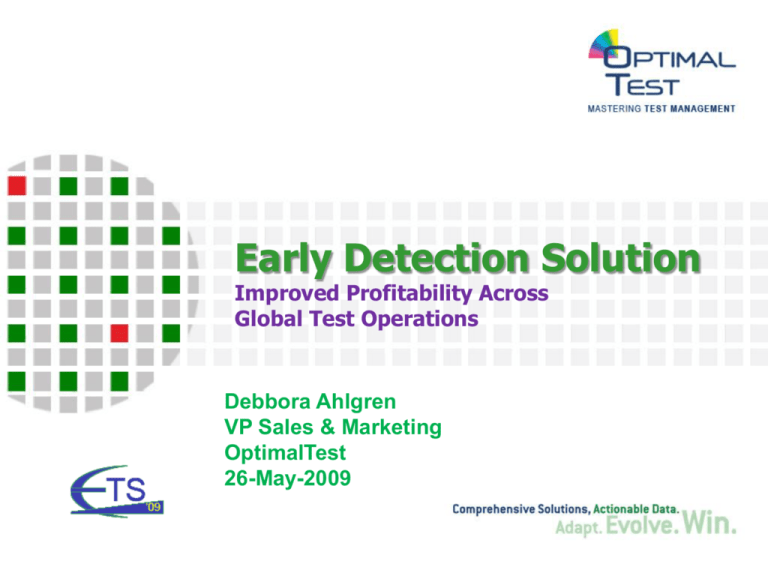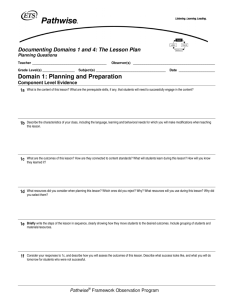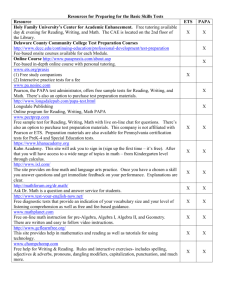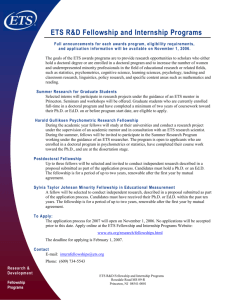Early Detection
advertisement

Early Detection Solution Improved Profitability Across Global Test Operations Debbora Ahlgren VP Sales & Marketing OptimalTest 26-May-2009 OptimalTest/ETS 2009 P# 1 Process Node (Year) 90nm (2003) 65nm (2006) 45nm (2008) 32nm (2010) 22nm (2012) Window Window of Of Opportunity Opportunity With the move to 300mmdiameter wafers, the price tag for an advanced production fab has become out of reach for all but the largest IDMs…* TI Source: Gartner, 2008 Source: Gartner, 2008 OptimalTest/ETS 2009 P# 2 Source: Broadcom, 2008 Systematic variations are contributing to >60% yield loss at the 65nm as Compared to <5% at the 350nm node. OptimalTest/ETS 2009 P# 3 Foundry Services OptimalTest/ETS 2009 P# 4 Goal is to Optimize Product Cost Balance of cost/value of Design, Manufacture, Yield Learning & Test OptimalTest/ETS 2009 P# 5 • DFT alignment with design TWG • Socket performance vs. frequency • Expansion of specialty devices • Adaptive Test • SiP & 3D silicon Test Suggest that the ITRS is cutting short the potential. The real potential is to work for transparency and interoperability across the integrated fabless manufacturing model. OptimalTest/ETS 2009 P# 6 Robust IT Infrastructure Promotes transparency across distributed value & supply chain Provides for the implementation of rules (through expert rules engine) that transcends lots, device families and enterprise boundaries Integrates Yield Learning, Quality and Reliability functions NPI Outlier Detection Advanced Adaptive Test for Yield, Quality and TTR OptimalTest/ETS 2009 P# 7 OptimalTest Value Propositions OptimalTest delivers solutions for optimized test operations through 4 levels of software capabilities: 1. Real-Time Control – of Test Cell Execution Station Controller (OT-Box) application Test Cell control in real-time: Yield Learning & Reclamation, Test Operations Efficiency (TTR, Test Cell degradation) Product Quality (outlier detection), and Quality 2. Real-Time Monitoring – of a fleet of Test Cells for Optimized Efficiency Control Room application Real-time fleet monitoring: Yield degradation prevention, Operational Efficiency & Immediate Quality Attention 3. Near-Time Detection – of Product & Test Operational Issues Early Detection Solution & OT-Dashboard Product quality & performance monitoring & fleet monitoring in near-time: Yield degradation prevention & Yield Reclamation, Operational Efficiency and Quality 4. Off-Line Analysis & simulation – of Test Operations: Products, Fleet, Processes Reporting, Analysis & Simulation applications and OT-Dashboard Product performance analysis & off-line simulation: Yield, Efficiency (TTR), and Quality (Outlier Detection) OptimalTest/ETS 2009 P# 8 What is the value of Early Detection? Test results are situation specific Specific device and specific test cell “Bad” and “Good” are not absolute measures Near Real-Time (or “Near-Time”) Post Processing using robust “expert” rules improves operational efficiency for test Re-evaluate specific device results vs other devices (historical and across multiple test cells) Such Operational Efficiency requires the establishment of a Baseline of Fleet, Product and Processes This requires a database and an expert rules engine – OT-Rules Only Early Detection supports the “Near-Time” evaluation & comparison of results across an entire fleet of testers Across multiple enterprises (SATs and distributed test floors) Across lots from multiple foundries OptimalTest/ETS 2009 P# 9 OUTLIER MANAGEMENT CAPABILITIES THROUGH STATE-OF-THE-ART ADAPTIVE TESTING OptimalTest/ETS 2009 P# 10 Location of Baseline Die selected according to various algorithms: 1. Next to E-test structures (for maximized correlation between test sockets) 2. Spread-out equally in each of the 3 ring areas (for maximized area coverage) 3. In areas of different yield signatures 4. In most of the lithography exposure locations 5. In areas corresponding with Fab defect sampled areas OptimalTest/ETS 2009 P# 11 Early Detection Solution - Implementation Data logs from any origin & any format are transferred to the OT database at the end of each Run / Pass / Execution An OptimalTest Station Controller (OT-Box) connected to any test cell; or A Proxy (OT-Proxy) on any tester; or OT-Proxy is a light piece of SW (a “deamon”) installed on a tester that communicates directly to the OT-Database Any data log format from any family / model of tester (i.e STDF - heavy or light, comprehensive or summary) Re-evaluation of the data logs is executed against 2 types of expert rules Product level rule: Executed whenever new datalog files enter the data base Cross-Entity rule: Executed on a defined periodic time basis Once per shift, once per day, etc. Once an issue is detected based on the defined rules An eMail is sent to the responsible personnel with a description of the problem and a link to a specific report (OT-Reports/OT-Dashboard) illustrating the issue; and An alert is sent to the responsible personnel; and A disposition action can be executed OptimalTest/ETS 2009 P# 12 SAT or Test Site Design House or IDM STDF 7C7 GDF File Drop Customer FTP Bulk Insert OptimalTest Parsing Server OptimalTest Database Other Formats Parsing of non-OTDF is more processor-intensive OptimalTest/ETS 2009 P# 13 SAT or Test Site Design House or IDM OTDF OptimalTest Database (SAT) File Drop Customer FTP Bulk Insert OptimalTest Parsing Server OptimalTest Database Each OT customer has their own OT Database OptimalTest/ETS 2009 P# 14 SAT or Test Site Design House or IDM OTDF OptimalTest Database (SAT) File Drop FTP Server Bulk Insert OptimalTest Parsing Server OptimalTest Database Each OT customer has their own OT Database OptimalTest/ETS 2009 P# 15 Product Rule Customer Defined Rules CrossEntity Rule (End of Wafer or Lot) (CustomerDefined Period) eMail Notification With attached report Rule Feedback Scheduled Analysis Proxy Any Other Testers OT-Dashboard OptimalTest DB OT- Dispo Automatic Disposition (e.g. hold/release lot) OptimalTest/ETS 2009 P# 16 Without OT OT-Proxy OT-Proxy2 OT-Box Full control of the test cell – tester, prober/handler - - - Automated and validated data entry - - - Datalogs, wafer maps and summary files always match - - - Capture of adaptive testing rules impact - - Post process validation of correctness of data - Robust file transfer infrastructure to ensure the data log reaches the database and other systems - (Load-Board; Sockets; Probe Cards etc) OT-Proxy A small, non-intrusive software component installed only on the tester that monitors the testing process and streams data to a backend server OT-Box A powerful station controller that takes complete control of the tester and prober/handler and implements OptimalTest’s full capabilities OTDF A new, XML based, compact datalog format with extensions for adaptive testing rule data. It is generated by the OptimalTest server and used primarily to transfer testing results to other systems in a “lighter” & efficient manner OptimalTest/ETS 2009 QCT/OT Confidential P# 17 Equipment Outlier Alert – Product exhibiting different yield on specific tester in a fleet or across enterprises “Manufacturer A” M220 SAT1_33 OptimalTest/ETS 2009 P# 18 (A rule alerting for a site yield degradation issue (>5%) OptimalTest/ETS 2009 P# 19 (A rule alerting for a site degradation issue (>5%) OptimalTest/ETS 2009 P# 20 Multiple layouts accessible via tabs Wide variety of "widgets" with all relevant KPI's Highlight outliers OptimalTest/ETS 2009 P# 21 Rule Efficiency Magnify yield fluctuations Outlier Equipment Alarms OptimalTest/ETS 2009 P# 22 1 4 7 2 5 8 3 6 OptimalTest/ETS 2009 Legend 1 – Device A Final Yield 2 ––Device Device A 1stst Pass Yield 3 – Device A Total Units 4 –Device – DeviceBBFinal SC2XYield 1st Pass Yield st Pass Units 56 – Device B 1Total Yield Rate (Facility 1 – with OT-Boxes -67 ––Device Device BB Retest Total Units crossing 5% threshold) 7isn’t – Device B Retest Rate (Facility 1 – OT-Boxes enabled) 8 – Device B Final Yield by Tester (Facility 1 “fleet” is isn’t crossing 5% threshold) 8stable) – Device B Final Yield by Tester (Facility 1 “fleet” is stable) P# 23 OptimalTest/ETS 2009 P# 24 Benefits of Early Detection Solution Results Re-Evaluation control, quality & health of all test operations Identify issues in: Yield, Efficiency, Productivity, Quality & Data-Integrity Detection of Outlier Equipment all test assets (ATE, peripherals, consumables) Proactive detection of trending and marginal equipment before they become outliers & before equipment failure (Fleet baseline) Detection of Product & Quality issues improved product quality and reduced field returns Proactive detection of Test Program instabilities & marginalities, Bin switching, Recoverability, Re-Tests, 1st pass yields, QA, Correlation / Golden-units pass rate, run-rate & performance issues Detection of Data Integrity issues consistent results and reliable decision making Proactive detection of Wafer Map orientation issues, Holes, STDF vs wafer maps vs Summary files vs shipping maps etc Detection of Operational Issues improved overall operational efficiency (OEE) Proactive detection of failure to follow operational processes and procedures. Pauses, Set-ups, Re-tests End-of-Line gate-keeping improved overall operational efficiency (OEE) Proactive verification that material was processed based upon the intended criteria (Flow, Disposition actions, yield, Retest etc) OT-Post Engine offers: Device Outlier Detection PAT, S-PAT, D-PAT, ULPY, NNR and other advanced outlier detection techniques Bin Re-Classification Better categorization of devices for device parameters including Speed, Voltage Parameter “matching” for optimized Multi-Chip-Package or System-in-Package performance OptimalTest/ETS 2009 P# 25





